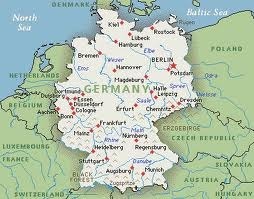Eleanor Sullivan's Blog, page 4
November 20, 2012
Blog Posts Translated into German!
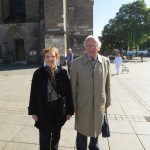
Peter Bachteler and me in Ulm, Germany
This is so exciting! Peter Bachteler, who lives in my ancestor’s hometown in Germany, Merklingen, is tranlating my blog posts into German! If you remember your high school German, try your hand at this. Otherwise, just enjoy the novelty.
Here’s one about our visit in the town:
Auf den Spuren der Separatisten in Deutschland: Erster Halt: Merklingen
Stellen Sie sich vor, Sie könnten die Zeit zurückdrehen, um zu erfahren, wie die Separatisten vor 200 Jahren in Deutschland gelebt haben. Möchten Sie nicht in die Häuser treten, in denen sie geboren wurden, um zu sehen, wo sie gelebt und gearbeitet haben? Und … wo sie für ihren Glauben gelitten haben? Das ist genau das, was 12 unerschrockene Reisende im September dieses Jahres unternommen haben!
Kommen Sie mit uns, wenn wir diese mutigen Leute auf ihrer Reise begleiten.
Unsere Gruppe bestand aus Nachkommen der ehemaligen deutschen Separatisten sowie Leuten, die sich für die Geschichte der Separatisten in Deutschland und ihre Siedlungen in Amerika interessieren. Die beiden Historiker: Dr. Eberhard Fritz und
Dr. Hermann Ehmer, begleiteten uns. Ihr umfangreiches Wissen sowie ihr Interesse an der Geschichte der Separatisten bereicherte unser Wissen sehr wesentlich.
Merklingen, ein Dorf mit rund 1800 Einwohnern liegt etwa auf halber Strecke an der Autobahn A8 zwischen München und Stuttgart im Bundesland Baden-Württemberg. Hier wurden Joseph Bimeler, der Leiter der Separatistengruppe aus Rottenacker am 26. Mai 1778 als Michael Bäumler und seine Frau Barbara Danzer am 24. April 1771 geboren. Michaels Geburtshaus wurde abgebrochen. Ein Scheuer steht heute auf diesem Grundstück. Das Geburtshaus seiner Frau brannte 1861beim großen Dorfbrand ab und wurde danach wieder aufgebaut.
Nach einer Lehrerausbildung an der Dorfschule in Grimmelfingen zog Michael nach Ulm und arbeitete hier als Pfeifenmacher.
Von seiner Familie und der Familie seiner Frau leben noch viele Nachkommen in Merklingen.
An einem sonnigen Nachmittag im September begrüßten uns einige Nachkommen der Familien Bäumler und Danzer mit großer Freude im Garten neben der Kirche, wo zahlreiche Aufnahmen gemacht wurden, um unser Zusammentreffen zu dokumentieren. Zwei Reporterinnen der beiden lokalen Zeitung besuchten uns. Sie waren die ersten, die über unsere einzigartige Reise in die Vergangenheit berichteten. Dann stiegen wir die Treppe zum Gemeindesaal hinauf, wo wir mit einem Nachmittagskaffee empfangen wurden. Neben dem köstlichen Kaffee mit Sahne und Zucker bedienten uns unsere Verwandten mit leckerem Weißbrot, das sie als “Nudel” bezeichneten. Warum? Es ist hier eine Tradition, am Sonntag die Spätzle durch das Weißbrot zu ersetzen. Da die Frauen des Dorfes nicht jeden Tag Spätzle machen wollten, entschieden sie sich dafür, am Sonntag von der Tradition abzugehen und servieren dafür dieses sehr sättigende kuchenartige Brot. Um bei der Tradition zu bleiben, nannten sie ihr Weißbrot “ Nudel!”.
Darüber hinaus waren die Stammbäume der Familien Bäumler und Danzer im Gemeindesaal aufgehängt, beginnend bei den ältesten Vorfahren bis zu den heutigen Einwohnern. Mit diesen Menschen zusammenzusein, mit denen einige von uns gemeinsame Vorfahren haben (obwohl sie kein Englisch und nur wenige von uns gut Deutsch sprechen), war es dennoch ein emotional bewegendes Erlebnis, das keiner von uns je vergessen wird.
Historische Fragen
Was haben wir über den Michael und seine Familie erfahren? Mehr als wir erwartet hatten!
Michael heiratete Barbara Danzer am 3. August 1802 in Ulm, wo er zu der Zeit lebte. Barbara war die Tochter eines Bauern aus Merklingen, der auch Pferde besaß, ein Kennzeichen für seinen Wohlstand. Warum haben sie geheiratet, fragen Sie? Ihre Tochter auch namens Barbara wurde am 18. Januar 1803 geboren. Können Sie rechnen? Michael heiratete eine ältere Frau (sie war 31, er 24) und bekam eine große Mitgift und die Familie Danzer konnte sich einer legitimen Enkelin rühmen. Ja, bedenken Sie, dass die Geburt im Geburtsregister als “illegitim” bezeichnet wurde.
Dr. Ehmer erläuterte, wie Michael den Namen Joseph bekam. Die meisten Aufzeichnungen über den Leiter von Zoar verwenden entweder den Namen Michael oder den Namen Joseph oder beide zusammen, wie es damals üblich war. Ebenso war es bei seinem Sohn Peter, der als Johann Peter geboren wurde. Stellen Sie sich unsere Überraschung vor, als Dr. Ehmer uns erklärte, dass sein Geburtsname “Michael Bäumler” war ohne den Vornamen Joseph. Wir wussten schon, dass Bäumler in Bimeler amerikanisiert worden war. “Aber wie,” fragten wir Dr. Ehmer, “ wurde aus Michael Joseph ?” “Ah”, sagte Dr. Ehmer, “, er wollte vielleicht durch einen weiteren biblischen Namen bekannter werden!”
Was haben wir gelernt? Dass die Menschen, auch unser verehrter Leiter von Zoar, alle menschlich sind. Sie hatten menschliche Wünsche, Träume, Ängste und Schwächen, so wie wir heute. Heißt das, dass sie weniger verehrenswert sind? Natürlich nicht. Es macht sie erst zu richtigen Menschent.
(Stay tuned?) Erwarten Sie Erzählungen über die Separatisten, wenn Sie sich mit uns auf diese bemerkenswerte Reise begeben.
Thank you, Peter Bachteler!!
November 15, 2012
Tracking the Separatists in Germany: Next Stop: Rottenacker
Last time you came along with us as we traced the Separatists in Germany to Merklingen, the birthplace of Joseph Bimeler and his wife, Barbara Danzer. Come along now as we travel on to Rottenacker, the home of many of the Separatists.
Barbara Grubermann
No discussion of the Separatists is complete without considering Barbara Grubermann’s contribution to their founding. Plus, she’s a fascinating character! Born in Switzerland on February 5, 1797, Barbara (also known as Babele, a common nickname for Barbara) quickly asserted her independent spirit, refusing to sit in her assigned seat in the church even as a young child. Here’s the interesting part: she experienced ecstasies, receiving revelations during her trances. Reporting that she’d seen the spirits of heaven and everyone could be cleansed and go there. No need for church, for ministers, or for catechism. All one needed to go to heaven was penance.
Imagine the formal church’s response to her revelations! And her increasingly popularity as people traveled from miles around to hear her speak. In January, 1789, she was sentenced to prison. She soon complained that she was confined in a narrow cell in a nearly naked condition but, instead of being released, she was transported to the penitentiary for women in Lindau. There she again fell into trances, converting a warden to her beliefs.
What did she do next, you ask? She escaped! And continued her travels, collecting converts along the way, including Stephan Huber, who became a leading Separatist later. (You’ll learn more about Stephan when we visit the prison next time.) Fearing arrest in Switzerland, she moved to Rottenacker, Germany, where she continued to espouse her beliefs but suffered no more than ridicule from some.Despite returning to Switzerland in 1804 to marry, she seldom stayed for more than a short visit. Rottenacker was now her home.
Rottenacker

Danube River near Rottenacker
During the early years of Separatism (1799 to 1800), the officials in Rottenacker ignored the Separatists’ disobedience. They didn’t attend religious services nor did the partake of the Holy Supper. But in 1801 the mayor complained about Barbara Grubermann’s teachings. She espoused working on Sunday and, he reported, she didn’t consider whoring a sin. What, you say, she encouraged sexual relations outside of marriage? That’s not exactly accurate. She neither condoned nor condemned extramarital sex. She simply decreed that no matter the sin, true Christians would be saved. She was ordered to leave Rottenacker, returning later when the brouhaha died down.
Rottenacker in Upper Swabia became the seat of Separatism. The people shared some common characteristics:
They attached a cloth star to their clothing to identify fellow Separatists and also mocked the authorities with its similarity to their official insignia.
Even leading citizens joined the movement, lending credibility to Barbara Grubermann’s teachings.
Many Separatists, though, were poor farmers who supplemented their meagor income by working as weavers.
Most Separatists joined the movement as couples, but those that didn’t raised havoc in their homes, i. e., beatings, abuse.
The Separatists celebrated with happy hymns that attracted church people because they were more joyous than their usual hymns.
The Separatists further insulted the authorities because they refused to doff their hats to their “betters.” Such an indignity! And they called everyone by the familial title as “du” as they considered everyone equal. Who had heard such blasphemy!
Historical Questions
We know that eventually Separatists were arrested and sent to prison (for the men) and the penitentary (for the women), but we don’t know what happened to Barbara Grubermann. She didn’t emigrate to America or Russia as some Separatists did. She seemed to keep on the move to avoid the authorities but eventually all word of her ceased.
Also, where did Stephan Huber and Michael Bäumler go? Huber was imprisoned for a time but then isn’t heard from until he and Bäumler appear in Zoar in 1817.
I’ll try to answer these questions in future posts. In the meantime, let me express special appreciation to Dr. Eberhard Fritz for his paper, “Separatists in Rottenacker” and for his lectures on the trip. Dr. Herman Ehmer also contributed his historical expertise.
Stay tuned for our next stop: the prison!
October 16, 2012
Tracking the Separatists in Germany: First Stop: Merklingen
Imagine if you could travel back in time to see how the Separatists lived 200 years ago in Germany? Wouldn’t you like to step into the homes where they were born? See where they lived and worked? And…where they suffered for their beliefs? That’s exactly what 12 intrepid travelers did in September!
Come along with us now as we track those brave people’s journey.
Our group consisted of descendants of the original German Separatists as well as people interested in the Separatists’ history in Germany and their settlement in America. Joining us were two historians: Dr. Eberhard Fritz, historian and archivist for the state of Baden Wuerttemberg, and Dr. Hermann Ehmer, archivist for the state of Baden Wuerrttemberg. Their vast knowledge, as well as their love for the Separatists and their history, enriched our experience immensely.
Merklingen
Merklingen, a town of about 1000 residents, is located about halfway between Munich and Stuttgart in the state of Baden-Wuerttemberg. It is the birthplace of Zoar leader, Joseph Bimeler (born May 26, 1778), and his wife, Barbara Danzer (born April 24, 1771). Joseph’s birth home is no longer; an empty lot stands in its stead. His wife’s birthplace burned to the ground but has since been rebuilt.

Where Joseph’s birth home stood in 1778
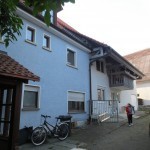
Barbara Danzer’s birth home rebuilt after fire
As an adult, Joseph moved to Ulm and became a maker of men’s pipes, but his brother, Ulrich, and his sister, Ursula, remained in Merklingen and their descendants are still there!
On a sunny September afternoon, these descendants greeted us in the church yard with enthusiasm where numerous photographs were taken to commenorate our reunion. A reporter and photographer with the local newspaper joined us, the first of three papers who recorded our unique journey into the past. Then we ascended the steps to the church hall where we were feted with an afternoon coffee in our honor. Beside delicious Kaffee mit Sahne und Zucker, our “relatives” served a scrumptious bread they called a “noodle.” Why? It was a tradition to serve spaetzle (a short noodle common to the area). Tired of the everyday noodle, the women of the town decided on defy tradition (yikes!) and serve this rich, cake-like bread instead. To cover their tracks, so to speak, they called it a noodle!
In addition, the Bimeler and Danzer family trees were displayed in the hall, tracing the earliest inhabitants down to today’s residents. To be with these people, with whom some of us had common ancestors (even though they spoke no English and few of us spoke much German), nonetheless was an emotionally moving experience, one none of us will ever forget.
Historical Questions
What did we learn about the Joseph and his family? More than we expected!
Joseph married Barbara Danzer on August 3, 1802 in Ulm, where he was apparently living. Barbara was the daughter of a Merklingen farmer who also owned horses, an indicator of wealth. Why did they marry, you ask? Their daughter, also named Barbara, was born January 18, 1803. Do the math! So, Joseph married an older woman (she was 31, he, 24) and gained financially, and the Danzer family could boast of a legitimate granddaughter. Yes, the birth records of that day note a birth that’s “illegitimate.”
Dr. Ehmer explained how Joseph got his name. Most records about Zoar’s leader use Michael or Joseph as his name or combine the two as was common in that day. In fact, his son, known as Peter, was born Johan Peter. Imagine our surprise when Dr. Ehmer explained that his birth name was “Michael Bäumler,” no mention of Joseph. We’ve known that Bäumler was Americanized to Bimeler. No mystery there. “But how,” we asked Dr. Ehmer, “did Michael become Joseph?” “Ah,” Dr. Ehmer said, learning back, “he wanted to be known by a more Biblical name!”
What have we learned? That people, even our revered Zoar leader, are all human. They had human desires, dreams, fears, and foibles, just as we do today. Does that make them less honorable? Of course not. It makes them more real.
Stay tuned for future tales to Separatist sites as you travel with us on this remarkable odyssey.
October 2, 2012
Americans Look for Traces of Their Fathers
This article appeared in the Schwaebishe, Germany paper on September 21, 2012. Note the translation reflects the way German sentences are constructed.
MERKLINGEN / cm
A dozen people from Zoar in the State of Ohio in the United States on their visit to Germany on Thursday Merklingen paid a visit to find out about the founder of their home town comprises around 200 inhabitants closer.This village founder was Joseph Baumler (Americanized Bimeler). When Michael Baumler he was on 26 May was born in 1778 and emigrated in Merklingen as head of a separatist group from Rottenacker in 1817 to the United States.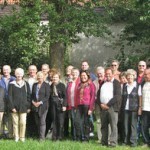
Bimeler took time with his only son, Peter, to America, his wife died in 1804, his 14-year-old daughter Barbara remained in Germany and married to Gerstetten. Bimeler, who preached at the beginning in the U.S. or celibacy, later married his housekeeper Dorothy.
Zoar was named in 1817 by German religious dissenters, “Society of Separatists of Zoar,” founded.The separatists or Zoarites emigrated from the kingdom Württemberg due to religious oppression of the Lutheran Church. Head of the society was the Ulm pipe maker Joseph Bimeler. His charismatic leadership carried the village, according to the history of Zoar by a series of crises.
The author of the Encyclopedia Württemberg “Mountains and Danube, Art and Culture” is Fritz Eberhardt, historian Altshausen (Ravensburg), who accompanied the group and also about the “songbook of Michael Baumler” writes. The name of Zoar was loud Fritz probably derived from the biblical site Zoara, left the Lot and his two daughters, as Sodom and Gomorrah perished.
The group from the United States visited on Thursday morning already the Gothic cathedral, the fishing quarter and Baumler residences in Ulm, where she was accompanied by Peter Bachteler interests of the community of history and traditions in Merklingen (IGM). ”We had a great morning and look forward to the next day when we visited Ludwigsburg, Tübingen, Heidelberg and some castles,” said Eleanor Sullivan. Highlight of the trip will be anything but: “The meeting with the German relationship.”
The connection to the U.S. was in 2001 about Peter Bachteler Hansjörg Rothenbacher, make a cousin of Blaubeuren. He then spent a while America. We remain in close contact with Peter Bachteler the “American Lingern Wish”.
Thank you Dr. Eberhard Fritz, my fellow travelers, and our relatives in Germany!
September 16, 2012
Following in My Ancestors’ Footsteps
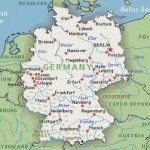 Soon I start on a trip to follow in the steps of my ancestors—across the ocean (albeit by plane) and dropping down in Munich. Then we (12 of us interested in Separatist history) travel by bus (not on foot as they did) to Ulm and on to Merklingen where Joseph and his brothers and sister were born—on my birthday! WooHoo!
Soon I start on a trip to follow in the steps of my ancestors—across the ocean (albeit by plane) and dropping down in Munich. Then we (12 of us interested in Separatist history) travel by bus (not on foot as they did) to Ulm and on to Merklingen where Joseph and his brothers and sister were born—on my birthday! WooHoo!
But here’s the interesting news: Joseph’s brother, Ulrich, and his sister, Ursula, stayed in Merklingen as did all of their descendants except those who died in the world wars (one is listed as “missing in France” another “killed in Russia”) I will meet many of them there.
Then on to Rottennacker where the Separatists developed a following. One of the Pietist sects emerging in the late 18th century in Europe, the Separatists believed that each person had a personal relationship with God and needed no priest, no sacrament, nor sybolism for their salvation. Thus, they refused to follow the state church-Lutheran at the time, keeping their children out of the state school (also Lutheran), foregoing mandated church attendance and the final indignity–refusing to doff their hats at their “betters.” For this they were severely persecuted–thrown in prison, caned, thrashed (two people died from their beatings), and lost their children to orphanages.
With the help of Dr Eberhard Fritz, historian and archivist for the Duke of Wuerttemberg, and Dr. Hermann Ehmer, archivist for the state of Baden Wuerttemberg we will visit the Separatist-related sites of Rottenacker, Merklingen, Hohenasperg and Mon Repos. We will see where they were imprisoned and suffered under “hard labor, and visit Wilhelmsdorf, a Pietist village where the Separatists tried to create their own community in Germany near Ulm.
Not to leave you in suspense about what happened to the Separatists, I can reassure you that they found a welcoming home in America. With the help of Quakers in England, a small band of beleaguered believers, made their way to America to establish a community in Northeast Ohio that they named Zoar for the place where Lot had found sanctuary in Arabia much as they had found sanctuary in America. Their leader, Joseph Bimeler, is my 4th great grandfather. Today, I celebrate the lives of these intrepid settlers with my Singular Village Mystery series. Cover Her Body is the first; Graven Images will follow next year. And maybe, just maybe, I’ll find a story in historic Germany.
In the meantime, I take my readers, my family, and my friends with me on this journey.
Auf Wiedersehn!
August 31, 2012
Travel to Utopia: Societies Seeking the Garden of Eden
Did you know that other communities existed in 19th century America similar to Zoar? Let’s travel back in time to some of them.
The Communal Society of the Harmonists
The first we encounter is New Harmony, Indiana. The Harmony Society, like the Society of Separatists, carved a town, called Harmony, out of the wilderness in the early 1800s, but their efforts were not as successful as the Separatists. Many died of malaria within the first year. Even after building a substantial village and living there for ten years, they sold the town Robert Owens in 1825. Naming it New Harmony, Owens intended to establish a utopian community but his efforts failed within two years.
Shaker Village at Pleasant Hill
Next we encounter the Shaker Village at Pleasant Hill in Kentucky. Attracted by the rich farm land, former members of eastern Shaker communities recruited new converts and settled the community at Shaker Village in 1806. Hard-working and devout, the Shakers tilled the fertile land, raised livestock, and marketed their goods (they became known for their fine corn brooms.) to surrounding communities (similar to the Separatists).The Shakers, however, heeding the words of their original leader, Mother Ann Lee, to remain celibate. Alas, that led to their eventual demise.
The Amana Colonies in Iowa
Of German descent, as were the Separatists, the settlers of the Amana colonies believed that God spoke directly to man (why are women never mentioned in early accounts?) without a church or a priest interceeding. Arriving in Iowa in 1855, they, too, lived communally, worked hard, and found prosperity in their new homeland. Like Zoar, the Amana Colonies declined when the railroad invaded the west and the industrial revolution made their hand-made goods obsolete.
The good news about all these towns? Restored buildings, trained interpreters, museums, and gift shops make each of them a worthy place to visit. Just be glad you don’t have to travel like these inhabitants did!
August 13, 2012
Travel in Early 19th Century America
Pride in America loomed large in the 19th century. A revolution had freed men (not women, not blacks) from England’s yoke. In 1829 Andrew Jackson was elected by popular vote, ushering in an era when all common men realized they could become president. Ambition and open land beckoned to foster westward migration. It seemed that nothing would stop these intrepid adventurers as they made their way onward to fame and fortune.
19th Century Road Travel
Imagine you’re an early 19th century traveler. What were the roads (if there were any) like? In the spring mud filled potholes could sink a wagon wheel or hobble a horse. So, you’d walk, you say. How far can you go in a day? What about food and water? And where would you sleep? These are just a few of the hazards you’d encounter in traveling the roads in 19th century America.
Travel on the Erie Canal
Begun in 1817 and finished in 1825, the Erie Canal was hailed as an engineering marvel of its time and heralded for opening the west to eastern travelers. Westward expansion was inevitable as settlers searched for more land, more freedom, more fame. Even the Separatists of Zoar, Ohio, accepted the state’s commission to dig the canal through their land, opening the secluded village to more and more visitors.
But was travel on the canal much better than by road? See what you think.
The boat consisted mostly of a cabin and was pulled through the water by horses walking on a parallel towpath.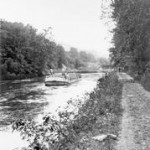
While you might sit atop the cabin to see the passing countryside but beware if a bridge is ahead. One woman fell asleep with her head on a box and didn’t hear the captain’s alert. Sadly, her head was crushed.
Travel to and across America didn’t stop. Other utopian societies, similar to the Separatists, braved the wilderness to settle religious commuties in their own search for a garden of eden. Next time we’ll visit three of them. Can you guess which ones?
July 29, 2012
Do You Have German Ancestors, too?
Does your ancestry include relatives who were born in Germany? Probably. The majority of Americans have some German ancestors, but sometimes we’re reluctant to admit it. Two devastating wars forced German-Americans to Anglicize their names and deny their heritage. But we do a disservice to our distant relatives who were adventurous enough to come to America and are responsible for our being here today.
Since I write about my ancestors, I imagine them as real people with hopes and dreams and foibles. I don’t paint the ones who came to America or those living in Germany today with the broad brush of responsibility for past acts of their leaders. But I often encounter vehement dislike for anything German related while, at the same time, German language classes are booming, according to the principal of the local German school. I asked her why. Some people are moving there with their jobs, some plan to vacation there, and some want to track ancestors, as I do. Maybe discrimination is subsiding.
My experience with traveling in Germany and staying with a German family was all positive. Germany is a lovely country with hard-working people (probably somewhat responsible for our work ethic) who treasure beauty, good food, enjoying life, and family. And musik! From Beethoven and Bach to folk musik, they love it all. Everywhere flower boxes overflow with carefully-tended blooms, and outdoor cafes are filled with families enjoying each other. Food is savored, not swallowed hurriedly at work. In fact, after traveling to Europe numerous times, I’m struck by how often Europeans know how to savor the small things in life–a crisp white tablecloth graced with fresh flowers and real butter for savory bread, regular breaks in the day (the English have tea time perfected!)
What makes Americans different? Why do we rush around with never enough time to enjoy life? Don’t blame technology. It’s been ever thus. Ask anyone how they are and what do they say? “Busy,” right? Does that indicate how important we are? Hardly.
Here’s one guess: Those ancestors of ours–from whatever country–struggled to survive the dangerous trip to America. They had what Mary Tyler Moore’s boss observed about her: spunk. Then they crossed the countryside against almost intolerable odds to settle and raise families. And here we are with spunk in our genes. Just a thought.
So, I thank all my ancestors wherever they came from and I treasure my heritage. I wouldn’t be here without them!
July 22, 2012
How I Turned My Ancestors’ Lives into Fiction
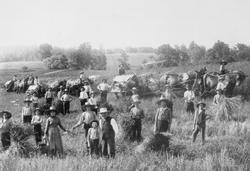
Separatists at work
I write historical mysteries set in the real-live village of my ancestors (Cover Her Body), but I didn’t intend to fictionalize their actual lives. But that’s exactly what I did in my last two posts. In my defense, I thought I was telling the truth, the truth as I’d been told in family tales. Alas, I’ve been corrected.
On my post dated June 29, I stated that little was known about my 4th great grandfather’s early life. Historian Eberhard Fritz in Germany told me that wasn’t true. In fact, Dr. Fritz explained that he’d written about Joseph Bimeler in his 2003 doctoral dissertation and had recently found more information in the archives. I will have the great good fortune to meet Dr. Fritz when I travel to Germany in September and I’m looking forward to learning more about Joseph’s life before he came to America to lead the Separatists.
In the same post I said that I didn’t know why Joseph’s daughter, Barbara (he left her behind when he left Germany) didn’t marry until age 27 and, even more importantly, why she married a man deemed “illegitimate” according to historical records. Again, Dr. Fritz came to my rescue, explaining that poor girls often weren’t allowed to marry and Barbara was especially undesirable because her father was a Separatist, a “bad citizen,” Dr. Fritz explained. I can only imagine what a sad life she had. She died at age 42.
I thought that was all I had misreported but, no, my 4th cousin, Donna Barnhill, tells me I made a mistake in my next post on July 11 when I wrote about Joseph’s son, Peter. I explained that Peter had three children: Levi (I’m descended from him), August, and Pauline. Wrong, my cousin says. Peter and his wife, Anna Maria, also had a daughter, Mary, born in 1840. To add to the mystery (sorry, pun intended), Mary’s birth only appears on some records, not all of them. She married Jacob Ackerman and stayed in Zoar until her death. Who is this mysterious Mary?
So, here’s a big thank you to Eberhard Fritz and Donna Barnhill who’ve been kind enough to enlighten me. Thanks to you more is known about these fascinating people!
July 11, 2012
My 3rd Great Grandfather–the Hapless Peter
If you read last week’s blog, you know that Joseph Bimeler escaped from religious persecution in Germany to lead a beleaguered band of believers to America in 1817. A widower of ten years, he left a fourteen-year-old daughter behind but brought his thirteen-year-old son, Peter with him.
Johann Peter Bimeler
Born 7 March 1804
Known as Peter, the boy traveled with his father and his group on a ship leaving Antwerp April 1817 and arriving in Philadelphia in August 1817. Can you imagine the conditions they endured? They traveled in steerage and many in their group were ill by the time they reached America. Quakers in Philadelphia took them in and found work for those who wanted to stay there. Led by Peter’s father, Joseph, a small group set out in November for the land they had purchased in Eastern Ohio. We don’t know if Peter went with them. In fact, historical records have little information about Peter. Did he get along with his father, who was known to be overbearing? I suspect that his father dominated him as much as he did others.
The few records about Peter only say he was put in charge of the chicken coop, such a low level job as to be almost a slap in the face to Peter. Which is perfect for my stories! While I can legitimately portray Joseph as a authoritarian, Peter emerges as the hapless man I suppose he was. A spot on foil to his father in my fiction.
After marriage was again allowed in 1829, Peter married Anna Maria Vetter 14 March 1830 and the newly-weds lived in the same cabin with his father and Dorothea.
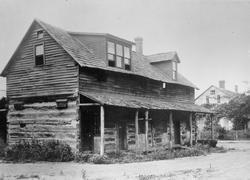
Bimeler family cabin
In spite of the close quarters, Peter’s ineptitude apparently didn’t extend to his ability to parent children. (Am I ever grateful to Peter!)
Peter and Anna Maria had three children: Levi (born 1834), August (born 1837), and Pauline (birthdate unknown). Nothing more is known of Peter and Anna Maria’s life in Zoar. What work did Anna Maria do? In addition to keeping house, cooking, baking, spinning, sewing and keeping a kitchen garden, all the women were assigned to an industry–sewing haus, bakery, dairy, or washhouse.
Peter died in 1861, only eight years after his father’s death, and Anna Maria followed her husband in death seven years later.
Levi Bimeler is my 2nd great grandfather. His daughter, Dorothea (not to be confused with Joseph’s second wife, Dorothea) was my great grandmother.
More about them next week.

